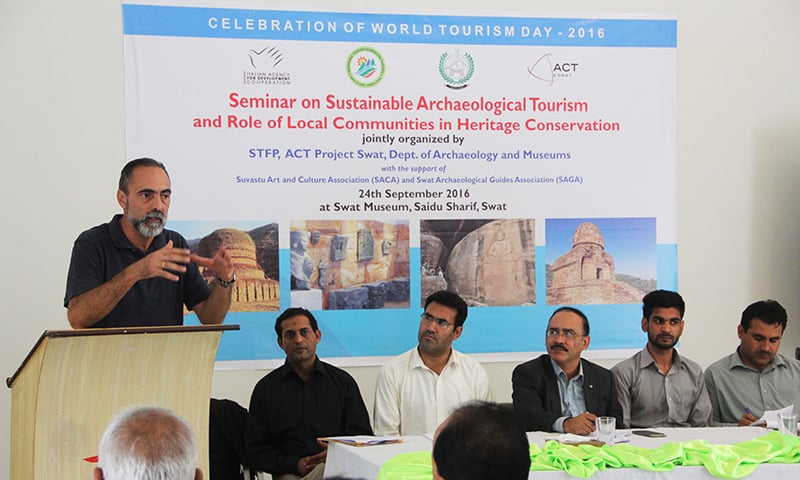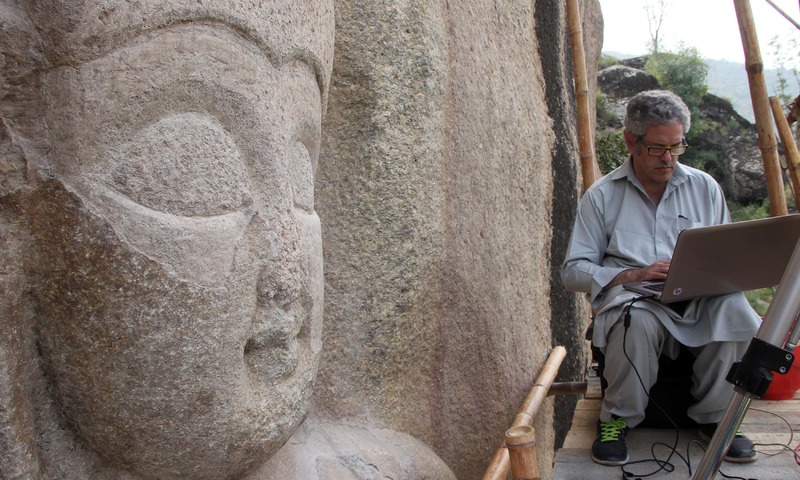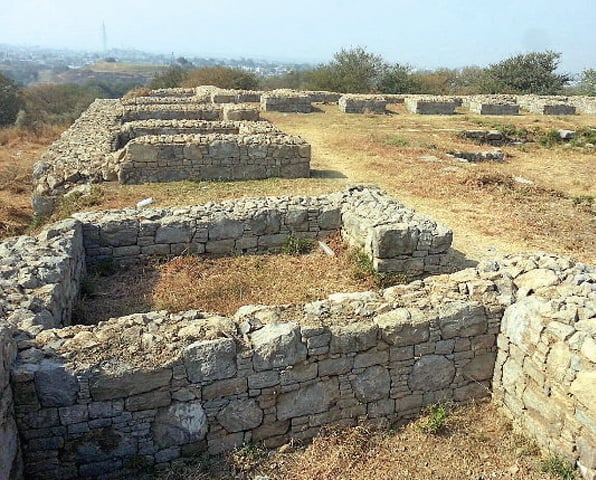Kambojaric
MODERATOR

- Joined
- Apr 6, 2010
- Messages
- 5,474
- Reaction score
- 16
- Country
- Location
Pashto book on archaeological sites of Gandhara civilisation launched

Gandhara, the first Pashto book on the archaeological sites of Gandhara civilisation was launched at a simple ceremony at the Peshawar Museum on Tuesday.
Compiled by senior journalist and reporter of Mashaal Radio, Khalid Khan Kheshgi, the book is a compilation of the radio programmes aired on the radio under the titled of “Da Tareekhpanry” (pages from history). Comprised of 21 chapters, with each chapter telling the story of one historical site in the province, the book has been produced by the Mashaal Radio.
The book launching ceremony was attended by many people from different walks of life. Khyber Pakhunkhwa Minister for Culture Mahmud Khan was the chief guest on the occasion while the ceremony was also addressed by Charsadda Bacha Khan University Vice Chancellor Prof Dr Fazle Raheem Marwat, Prof Abasyn Yousafzai, Culture Director Dr Abdul Samad and Mashal Radio Bureau Chief Alamzeb Khan.
Speaking on the occasion, Mahmud lauded the publication of the book on Gandhara sites, which he said was a great effort to highlight the historical places of the province. The minister also spoke about some projects initiated by the provincial government for promotion of cultural and heritage of the province.
He said the provincial government would soon launch the walled city project to revive the historical beauty of Peshawar. He said that three more museums were also being established in different parts of the province. He said that some more historical sites in Swat Valley would be explored and developed.
Museum Director Samad said that Gandhara is a unique book on the archaeological sites, which has been compiled by a non-archeologist and is written in very simple and common language. He said it is a good contribution to the study of archeology in the province and it would be very fruitful for common people of the province. He also spoke about some initiatives being taken by the provincial government for preservation of the archeological sites in the province. He said that the ‘Antiquity Act’ adopted by the provincial government is a major step for preservation of the cultural heritage of the province.
He said that the directorate of archeology and museums has also focused attention on exploration of more and more sites and developing the existing ones to use them as tourist resorts. He said that currently, the province has 12 museums and 6000 archaeological sites. He maintained that the archeological sites in the province have not been properly explored. If they are explored properly, they could be used as good spots for tourism, he added.
Prof Yousafzai said that the book is the best effort to compile knowledge about the historical places of the province in a precise and beautiful manner.
http://www.pakistantoday.com.pk/201...ical-sites-of-gandhara-civilisation-launched/

Gandhara, the first Pashto book on the archaeological sites of Gandhara civilisation was launched at a simple ceremony at the Peshawar Museum on Tuesday.
Compiled by senior journalist and reporter of Mashaal Radio, Khalid Khan Kheshgi, the book is a compilation of the radio programmes aired on the radio under the titled of “Da Tareekhpanry” (pages from history). Comprised of 21 chapters, with each chapter telling the story of one historical site in the province, the book has been produced by the Mashaal Radio.
The book launching ceremony was attended by many people from different walks of life. Khyber Pakhunkhwa Minister for Culture Mahmud Khan was the chief guest on the occasion while the ceremony was also addressed by Charsadda Bacha Khan University Vice Chancellor Prof Dr Fazle Raheem Marwat, Prof Abasyn Yousafzai, Culture Director Dr Abdul Samad and Mashal Radio Bureau Chief Alamzeb Khan.
Speaking on the occasion, Mahmud lauded the publication of the book on Gandhara sites, which he said was a great effort to highlight the historical places of the province. The minister also spoke about some projects initiated by the provincial government for promotion of cultural and heritage of the province.
He said the provincial government would soon launch the walled city project to revive the historical beauty of Peshawar. He said that three more museums were also being established in different parts of the province. He said that some more historical sites in Swat Valley would be explored and developed.
Museum Director Samad said that Gandhara is a unique book on the archaeological sites, which has been compiled by a non-archeologist and is written in very simple and common language. He said it is a good contribution to the study of archeology in the province and it would be very fruitful for common people of the province. He also spoke about some initiatives being taken by the provincial government for preservation of the archeological sites in the province. He said that the ‘Antiquity Act’ adopted by the provincial government is a major step for preservation of the cultural heritage of the province.
He said that the directorate of archeology and museums has also focused attention on exploration of more and more sites and developing the existing ones to use them as tourist resorts. He said that currently, the province has 12 museums and 6000 archaeological sites. He maintained that the archeological sites in the province have not been properly explored. If they are explored properly, they could be used as good spots for tourism, he added.
Prof Yousafzai said that the book is the best effort to compile knowledge about the historical places of the province in a precise and beautiful manner.
http://www.pakistantoday.com.pk/201...ical-sites-of-gandhara-civilisation-launched/

























